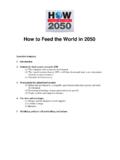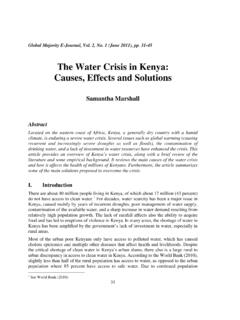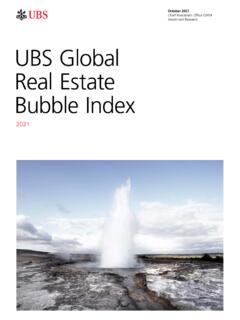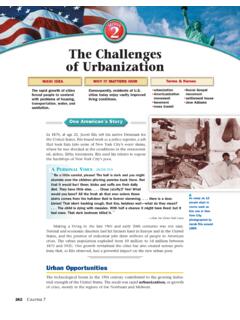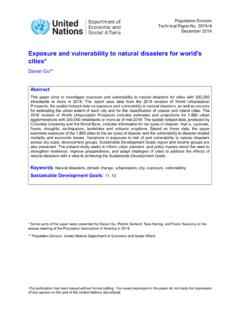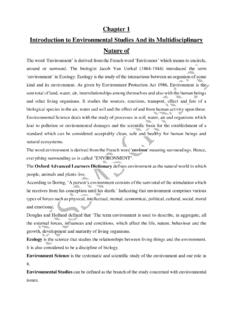Transcription of The growth of cities - OECD
1 The growth of citiesGilles Duranton University of PennsylvaniaandCEPRD iego Puga CEMFIandCEPRMay2013 Abstract: Why do cities grow in population , surface area, and incomeper person? Which cities grow faster and why? To these questions, theurban growth literature has offered a variety of answers. Within an inte-grated framework, this chapter reviews key theories with implicationsfor urban growth . It then relates these theories to empirical evidence onthe main drivers of city growth , drawn primarily from the United Statesand other developed countries. Consistent with the monocentric citymodel, fewer roads and restrictions on housing supply hinder urbangrowth.
2 The fact that housing is durable also has important effects onthe evolution of cities . In recent decades, cities with better amenitieshave grown faster. Agglomeration economies and human capital arealso important drivers of city growth . Although more human capital,smaller firms, and a greater diversity in production foster urban growth ,the exact channels through which those effects percolate are not clearlyidentified. Finally, shocks also determine the fate of cities . Structuralchanges affecting the broader economy have left a big footprint onthe urban landscape. Small city-specific shocks also appear to matter,consistent with the recent wave of random growth words: urban growth , agglomeration economies, land use, transportation, amenitiesjelclassification:c52, r12, d24 This is a draft of a chapter written for eventual publication in theHandbook of Economic growth , Volume2, edited bySteven N.
3 Durlauf and Philippe Aghion, to be published by Elsevier. We thank conference and seminar participants atthe Paris School of Economics and the2011 North American Meeting of the Regional Science Association for commentsand discussions. This research was developed in part when Duranton was visiting the Paris School of Economics, whosefinancial support is gratefully acknowledged. Puga gratefully acknowledges funding from the European Communities sSeventh Framework Programme underercAdvanced Grant agreement269869. Wharton School, University of Pennsylvania,3620 Locust Walk, Philadelphia,pa website: ).
4 Centro de Estudios Monetarios y Financieros (cemfi), Casado del Alisal5,28014 Madrid, Spain (e- @cemfi; website: ).1. IntroductionIn2010, the mean population size of the366 usmetropolitan areas was707,000, with a range to just over50,000. Between2000and2010, these cities grew on average first decade of the21st century was not exceptional forusurban grew on average per decade since1920, the earliest year for which consistent datais figure exceeds aggregate population growth pointseven though a growing population could be accommodated in more cities instead of larger it comes to urban growth , the United States is not an exceptional country.
5 In Spain, urbanareas grew on average between2000and2010, and per decade on averagebetween1920and2010, exceeding aggregate population growth in Spain France, metropolitan areas grew on average by4% between1999and2007, and perdecade on average between1936and2007, exceeding aggregate population growth in France by2percentage cities tend to grow over time, they do not grow uniformly at the same rate. Thestandard deviation of the growth rate ofusmetropolitan areas between2000and2010is slightlylarger than its corresponding mean. Observing individual city growth rates over a decade withmeans and standard deviations of about the same magnitude is typical.
6 This is the case for the1920 2010period in the United States, in Spain, and in France. These figures about the mean andstandard deviation of the growth rates of cities naturally lead to asking why cities keep growingeven after countries are already highly urbanized, and why some cities grow faster than able to answer these questions is important for at least three reasons. The first is thatthe population growth of cities is economically important in itself. Extremely large investments inbuilding new housing and infrastructure must be made to accommodate the demographic growthof cities . For instance, American households spend about a third of their income on housing,according to the Consumer Expenditure Survey.
7 For their part, various levels of theusgovernmentspend more than200billion dollar every year to maintain and expand the road that most of these investments are extremely durable, it is important to plan them properlyand, for this, we need to understand why and how cities , urban economics has proposed a number of theories to explain the population size ofcities. Following Alonso (1964), Mills (1967), and Muth (1969), a large literature has focused onthe importance of location within the city and its impact on commuting costs as a key determinantof land use and housing development in cities .
8 In turn, the ease of commuting, the availability ofhousing, and earnings determine the population size of cities . Following Rosen (1979) and Roback(1982), urban economists have also paid great attention to the role of amenities in attracting peopleto cities . Recognizing that earnings and productivity are themselves systematically related to the1 The computations for the United States are based on the2009definition of metropolitan areas. Using the earliestdefinition of metropolitan areas that can be applied to county population data, the1950 Standard Metropolitan StatisticalAreas, we observe a mean growth by decade on average between1920and2010.
9 These lower figures probably understate the true population growth ofuscities which, to some extent, grewthrough the expansion of their suburban areas that were not taken into account by the1950definition. On the otherhand, the figures based on2009definitions probably overstate the true growth ofuscities since they partly reflect theselection of the fastest growing cities that became the largest and form the existing set of metropolitan size of cities , much work has been devoted to modelling the productive advantages ofcities or agglomeration economies explicitly ( , Fujita,1988, Helsley and Strange,1990, Glaeser,1999, Duranton and Puga,2001).
10 The tradeoff between agglomeration economies and urban costs,at the core of systems of cities models building on Henderson (1974), is widely accepted as thekey explanation behind the existence of cities and provides some important implications for theirpopulation growth . Finally, the existence of some regularities in the size distribution of citiesand in the patterns of urban growth has motivated alternative approaches which emphasize theimportance of random shocks in urban growth ( , Gabaix,1999a).These theories offer useful guidance to conduct empirical work on urban growth by providingus with specifications and by highlighting a number of identification pitfalls.











